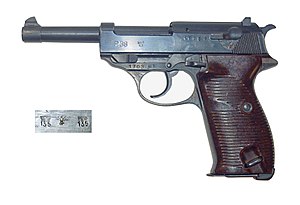Walther P38
| Walther P38 | |
|---|---|
| general information | |
| Military designation: | Walther P. 38 |
| Country of operation: | Germany |
| Developer / Manufacturer: | Carl Walther GmbH , Zella-Mehlis |
| Manufacturer country: | Germany |
| Weapon Category: | gun |
| Furnishing | |
| Overall length: | 213 mm |
| Total height: | 137 mm |
| Total width: | 37 mm |
| Weight: (unloaded) | 0.96 kg |
| Barrel length : | 127 mm |
| Technical specifications | |
| Caliber : | 9 mm parabellum |
| Possible magazine fillings : | 8 cartridges |
| Ammunition supply : | Bar magazine |
| Cadence : | Variable rounds / min |
| Fire types: | Semi-automatic |
| Number of trains : | 6th |
| Twist : | Right |
| Visor : | Fixed, 50 m, open sights (above rear sight and front sight ) |
| Charging principle: | Recoil loader |
| Lists on the subject | |
The Walther P.38 (original spelling with point) was a standard orderly pistol of the German Wehrmacht . It is a recoil loader with a barrel that slides back briefly and a swing bolt lock . The P1 , as the P.38 successor to the Bundeswehr is called, is almost identical in construction . However, its handle is made of light metal instead of steel in order to save 160 g in weight compared to the P.38. The firing pin and fuse have also been changed slightly.
history
The weapon was intended as a replacement for the 08 pistol, which was very complex and therefore expensive to manufacture. In the mid-1930s, Carl Walther GmbH therefore developed a new orderly weapon . In 1935 the Wehrmacht received a number of these new Walther army pistols . These were provided with an internal tap . For safety reasons - nobody could tell straight away whether the pistol was cocked - an improved model was commissioned, which was introduced to the Wehrmacht in 1938 as P.38 (customary spelling and stamping with a dot). Until 1945 the Walther-Waffenwerke Zella-Mehlis (ac), Spreewerk Grottau (cyq) and Mauser Oberndorf (byf, svw) produced the P.38 pistol in large numbers. After 1945 it was used again as a booty weapon with the permission of the Allied authorities at various institutions. Under French occupation, P.38 (marked with svw46 and star) were made from existing parts even after the German surrender. For the Bundeswehr and civilians, production of the P.38 and then the P1 was resumed in 1957. The successor to the P1 in the Bundeswehr is the Heckler & Koch P8 . By the end of the war, about 1.2 million of the P.38 had been produced.
Other versions
- Walther P1 : lighter grip, different firing pin and safety
- P4 : 110 mm barrel, different fuse
- P.38-K: 70 mm barrel, different fuse
- P.38 long: 152 mm barrel
Parts of the P4 or the P.38-K cannot be exchanged because there are tighter fits in the slide , for example .
literature
- Chris McNab : Handguns of the 20th and 21st centuries: pistols, revolvers, rifles, submachine guns, machine guns, grenade weapons . Kaiser, Klagenfurt 2007, ISBN 978-3-7043-1440-6 (English: Twentieth century small arms . Translated by Maria Schlick).
- OKW (Hrsg.): Pistole 38. Description, handling and treatment instructions . H. Dv. 254. Mittler, Berlin 1940.
- Gerard Henrotin: The Walther P38 Explained . H&L Publishing - HLebooks.com, 2005 ( hlebooks.com - ebook).
- Mauser: P38 Factory Drawings . (Drawings, online at archive.org )
The P.38 as a model
Design features of the P.38 were used by Walther for the Walther P4 and P5, as well as for various Beretta models (such as the Beretta 92 F alias M9 ). The P.38 was also the inspiration for the Smith & Wesson models 39 and 59.
Web links
- P38 at waffenHQ.de
- P38 at waffeninfo.net
- Walther P1 disassembled
- Work drawings from Pistole 38 1944/1945 (Mauser Werke AG)
- H.Dv.254 Pistole 38. Description, handling and treatment instructions from February 1, 1940 with cover sheet 1 from 1941 and cover sheet 2 from 1942
Individual evidence
- ↑ P. 38 & P1. The pistol family (Visier Special. No. 68), p. 6.
- ↑ P. 38 & P1. The pistol family (Visier Special. No. 68), p. 13.
- ↑ Gerhard Ortmeier, Walther P 38 as a model, in: DWJ (formerly Deutsches Waffen Journal) 2, 2014, pp. 76–81.
